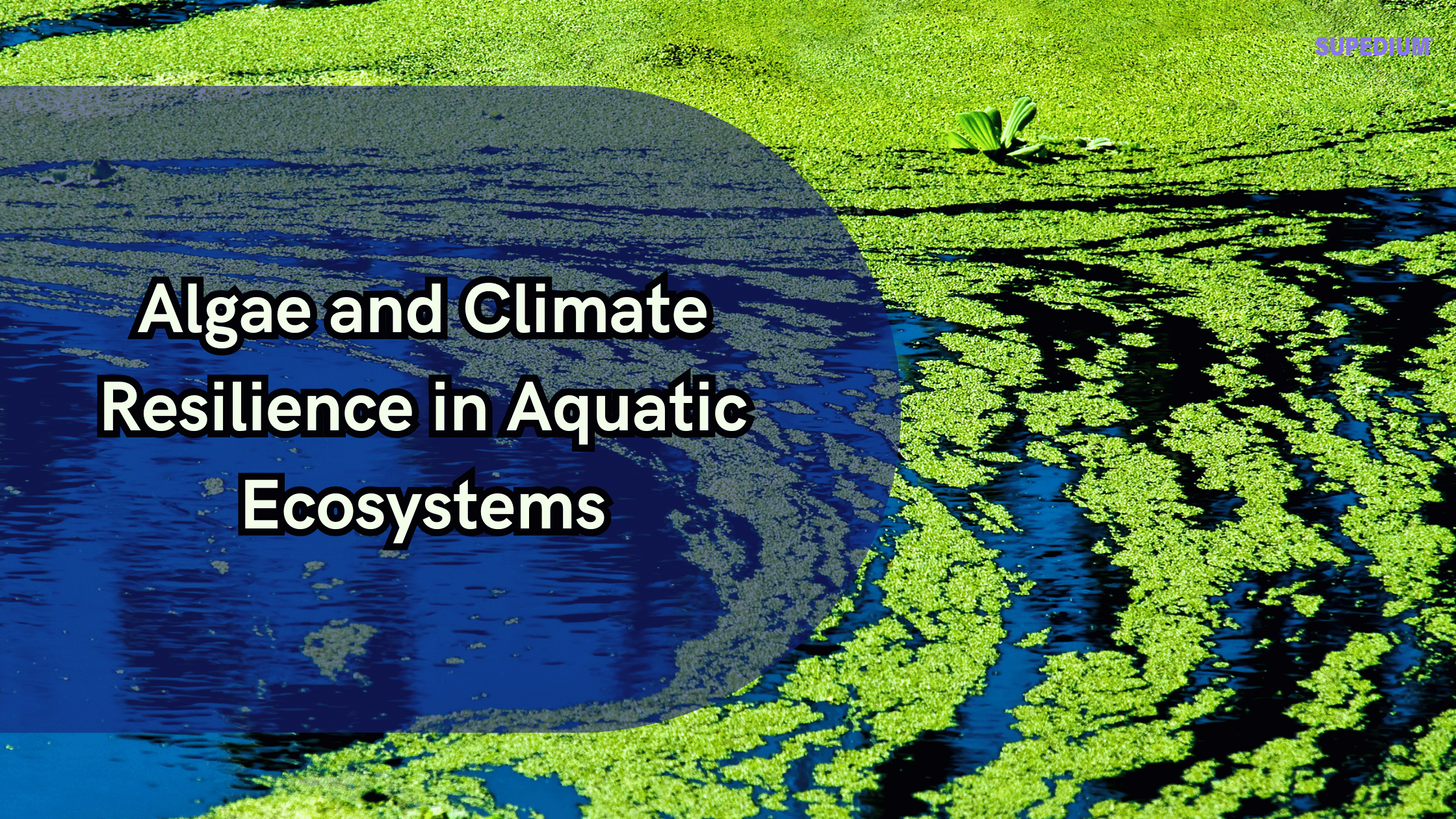Table of Contents
![]()
Introduction
Algae, a diverse group of photosynthetic organisms, play a crucial role in aquatic ecosystems. They are vital to the health and stability of these environments, serving as primary producers and supporting various ecological functions. As climate change exerts unprecedented pressures on our planet, understanding the role of algae in promoting climate resilience within aquatic ecosystems becomes increasingly important.
Algae: Characteristics and Functions
Biological and Ecological Characteristics
Algae can be categorized into microalgae (unicellular) and macroalgae (multicellular), encompassing a wide range of species from tiny phytoplankton to large seaweeds. These organisms perform photosynthesis, converting sunlight into energy and producing oxygen, which is essential for aquatic life. Algae also play a significant role in nutrient cycling, absorbing carbon dioxide and nutrients from the water, thus contributing to ecosystem health.
Roles of Algae in Aquatic Ecosystems
As primary producers, algae form the base of the aquatic food web. They provide energy and nutrients to herbivorous organisms, which in turn support higher trophic levels. Algae also contribute to habitat formation, offering shelter and breeding grounds for various aquatic species. Additionally, they influence water quality by regulating nutrient levels and maintaining the overall balance of the ecosystem.
Diversity of Algal Species and Their Adaptive Traits
The diversity of algal species is remarkable, with each adapted to specific environmental conditions. For instance, some species thrive in nutrient-rich waters, while others prefer more oligotrophic conditions. This adaptability allows algae to flourish in a range of aquatic habitats, from freshwater lakes to coastal marine environments.
Impact of Climate Change on Aquatic Ecosystems
Rising Temperatures
Climate change is leading to rising water temperatures, which directly impact algal growth and distribution. Warmer waters can enhance algal proliferation, particularly for harmful species, potentially disrupting food webs and leading to detrimental effects on aquatic life.
Ocean Acidification
The increase in atmospheric carbon dioxide is causing ocean acidification, which affects calcifying algae and associated species. This change can alter community dynamics and have cascading effects on the entire ecosystem, affecting everything from fish populations to coral reefs.
Altered Nutrient Availability
Changes in nutrient availability, often driven by agricultural runoff, can lead to eutrophication. This process causes excessive algal blooms, which can produce toxins harmful to aquatic life and humans. Moreover, shifts in nutrient cycling processes can disrupt the balance of aquatic ecosystems, further threatening their resilience.
Algae as Indicators of Climate Resilience
Indicator Species for Monitoring Ecosystem Health
Algae serve as valuable indicators for monitoring ecosystem health. Their responses to environmental changes can signal shifts in water quality and overall ecosystem stability. By studying algal populations, scientists can assess the impacts of climate change and other stressors on aquatic systems.
Role in Carbon Sequestration
Algae contribute significantly to carbon sequestration through their photosynthetic processes. They capture carbon dioxide and can store it in sediments, helping mitigate the effects of climate change. Understanding these mechanisms is vital for enhancing carbon capture strategies in aquatic ecosystems.
Algae’s Role in Enhancing Climate Resilience
Restoration of Aquatic Ecosystems
Algae can be instrumental in the restoration of degraded aquatic ecosystems. Algal-based rehabilitation projects, such as those utilizing bioengineering techniques, have shown promise in revitalizing habitats and improving water quality. These initiatives often lead to enhanced biodiversity and ecosystem function.
Mitigating Climate Change Effects
The potential of algae extends beyond ecological roles; they can also play a crucial part in climate change mitigation. Algae are increasingly being explored for biofuels and renewable energy, providing a sustainable alternative to fossil fuels. Additionally, their ability to bioremediate pollutants can help restore polluted water bodies.
Supporting Biodiversity and Ecosystem Services
Algae provide essential habitat for various aquatic organisms, supporting biodiversity. Their contribution to nutrient cycling and food webs underscores their importance in maintaining ecosystem services, such as water purification and carbon storage.
Challenges and Threats to Algal Resilience
Human Impacts
Human activities pose significant threats to algal resilience. Pollution and nutrient loading from agricultural and urban runoff can lead to algal blooms, which disrupt ecosystem balance. Additionally, habitat destruction through coastal development and damming rivers further exacerbates these challenges.
Climate Change Stressors
Climate change introduces a range of stressors that can affect algal communities. Increased frequency of extreme weather events, such as storms and floods, can alter habitats and nutrient dynamics. Furthermore, changes in hydrology and water availability can impact algal growth and distribution.
Invasive Species and Their Impacts on Native Algae
Invasive species can disrupt native algal populations, often outcompeting them for resources and altering community structures. The introduction of non-native species can lead to a decline in biodiversity and affect the resilience of aquatic ecosystems.
Case Studies
Successful Examples of Algal Interventions
Several successful projects have demonstrated the potential of algae in addressing climate challenges. For example, algal biofuels initiatives have shown promise in providing sustainable energy solutions while reducing carbon emissions. Similarly, algae have been employed in wetland restoration projects, enhancing water quality and biodiversity.
Comparative Studies of Resilient Versus Vulnerable Ecosystems
Research comparing resilient and vulnerable ecosystems highlights the importance of diverse algal populations. Ecosystems with a rich variety of algal species tend to exhibit greater stability and resistance to environmental changes. Understanding these dynamics can inform conservation and management strategies.
Future Directions and Research Needs
Advances in Algal Biotechnology
Research into algal biotechnology holds great promise for enhancing climate resilience. Genetic engineering can potentially develop algal strains with improved growth rates and stress resistance. Sustainable cultivation practices can also be developed to maximize the benefits of algal production.
Policy and Management Implications
Integrating algae into climate action plans is essential for effective management of aquatic ecosystems. Policies aimed at protecting and enhancing algal ecosystems can help mitigate the impacts of climate change and promote resilience.
Importance of Interdisciplinary Research
Addressing the challenges posed by climate change requires interdisciplinary collaboration. Scientists, policymakers, and local communities must work together to develop comprehensive strategies for protecting algal ecosystems and leveraging their potential in climate resilience.
Conclusion
Algae play a pivotal role in promoting climate resilience in aquatic ecosystems. Their diverse functions, from carbon sequestration to habitat provision, make them indispensable in the face of climate change. As we continue to explore the intricate relationships within aquatic environments, prioritizing the study and conservation of algae is essential for ensuring the health and sustainability of these vital ecosystems.
Share This





Be the first to comment